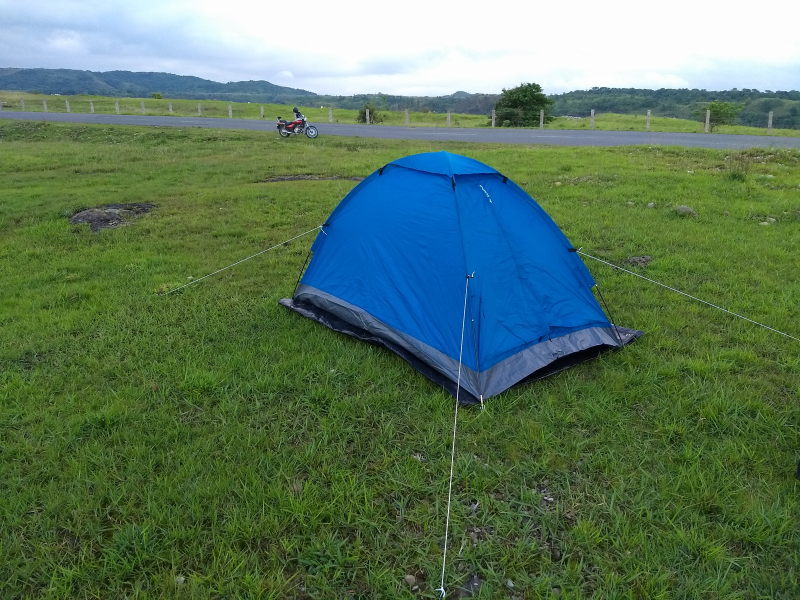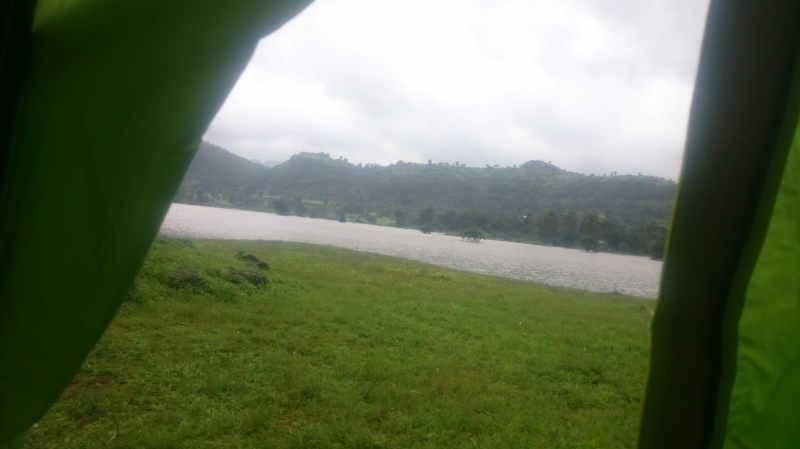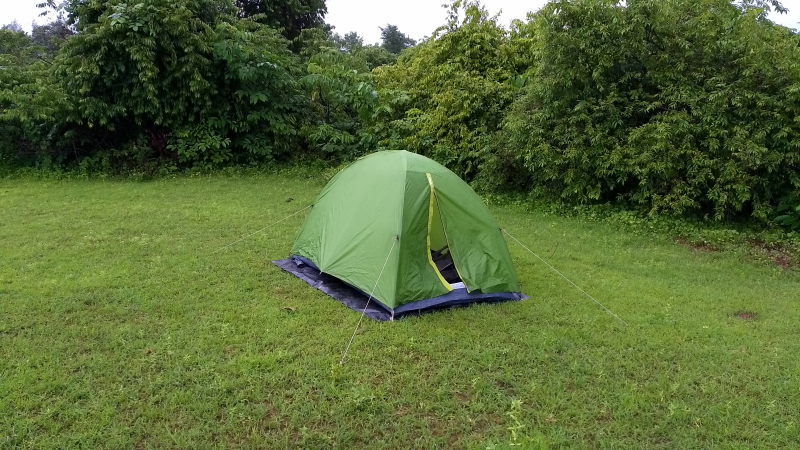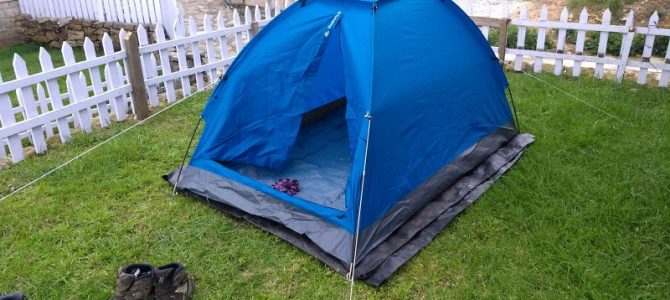Camping in India
In western countries, treks have established routes and designated camping spots. They have certain facilities like a place for camp fire and even benches for having food etc. Camping in India is nothing like that. So most of the articles in WikiHow are irrelevant here. In India 360 trip, we camped a few times in Maharashtra and Meghalaya. Camping served as a good back up plan for us and enabled us to walk out of demanding lodges that charged too much for too little. In Maharashtra and Telangana, we even slept in the car on the days we found no places conducive to camping.
To locate a camp spot to pitch a tent is a job of finesse and fine balance. We joke about finding a camp spot being like the killing of Hiranya Kashyapa by Narasimha Avatar of Lord Vishnu. Wondering what camping has to do with Narasimha Avatar? We will tell you.
camping: Where to set up a tent: the Right Place
The camp spot cannot be in the middle of a village (too much attention or even denied permission), or too far away from it (not having access to meals, help, etc). Neither can it be in the jungle, especially the ones that are frequented by elephants and wild cats. In several public spots, the local forest dept, the police and just about anyone can ask you to vacate your camp anytime. Private grounds often charge for pitching as much one charges for rooms. Your best bet is to find an unused / abandoned ground, 1 to 2 km into a sparsely inhabited road branching off a highway. You will most likely be left alone for the night, but you will also have access to the highway.

Camping off a highway near Mawlynnong, Meghalaya. Parked by the side of the highway is our motorbike.
The ground should not be too rocky with sharp ridges as it may hinder your sleep. Rocky surfaces also cause trouble in driving the piton to form a strong base for pitching the tent. Minimal grass on a leveled surface with mud is ideal. Too much grass may mean reptiles like snakes and so is best avoided. It should not have rained recently, as it might cause the camp area to get too muddy.

Camping near a lake in Maharashtra
Find a place within 200 metres of a water source, so that you can get your water pouches refilled for the night. This can be a river, lake or pond. However, do not camp within 100 metres of a river or a dammed lake, as flash floods may cause your camp to be washed away, even before you wake up and realise what is happening around you.
Camping: When to set up a tent: The Right time
In our road trips, we start looking for a camp site after 3 pm. Driving usually stops by 4 pm at the latest. We give ourselves 2 – 3 hours of sunlight between finding a spot based on our stringent criteria stated above and finally slinking into our pitched tent in relief and accomplishment. If there is no wind or rain, it usually takes us 15 – 20 mins to set up the tent. Wind and rain make the process more challenging and may require two persons to do things that one should have done. In heavy winds, there is a lot of holding and yanking, while one person stops the tent from flying away, and the other person does his/her best to drive the tent in place before the other partner tires of holding. During rains, it is a challenge to keep the inner membrane of the tent from getting wet.
If conditions are not suitable, and we are in our car, we often sleep in the car itself. Sleeping in the car always leaves us with a sleep deficit, due to sub-optimal posture, and the next day we end up sleeping in a nice comfortable hotel. We sleep early when we are in the tent, which is no later than an hour after sunset. We sleep well and wake up with the first rays of sun, packed up and ready to move by the time the sun is significantly over the horizon.
Challenges of camping
Camping holidays are glamorised by the tourism industry. We have found glamping in some places, e.g. Pangong Tso lake in Ladakh, to be costlier than hotels. If it were indeed that wonderful, we would not be spending so much to live in homes. Instead, we’d camp all the time.
While several notches below glamping, even treks with organisations like YHAI and IndiaHikes make people fall in love with campsites. They lament how polluted cities have become and how their urban lifestyle is meaningless. They do all this lamenting while sitting in the tents set up by the trek organiser’s fieldsmen, eating breakfast and sipping hot tea, both prepared by the trek organiser’s on-camp kitchen staff and having porters take care of heavy luggage like food rations, fuel, solar electrical gadgets and camping equipment. If only these city dwellers were to know what it takes to camp on their own, they’d be more grateful for their urban life loaded with creature comforts.
Trust us, camping on your own has its set of challenges and is definitely not for everyone. Camping looks rosy when someone else sets things up for you and if your holiday lasts for less than a week. Take matters into your own hands for weeks or months together and you will see that there are more tasks to do than the number of blissful moments to be had. As you can see from the above paragraphs, there are too many conditions, neither too far this way, nor too far the other, similar to the story of Goldilocks or the story of how Narasimha Avatar slays Hiranya Kashyapa.
Climatic Challenges
Pitching a tent requires a combination of utopian conditions which are hard to get in the real world. While too much wind can uproot a tent not set up well enough, too little wind can leave you gasping for air and feeling claustrophobic inside the tent. Rains can seep through the ground below you or spray through the wind vent at the side of the tent. While you may have set up the tent entrance when wind was blowing in one direction, it may change direction after it is set up causing the tent to be less stable. For multi-day camp sites, this will be a problem faced every day. And don’t even ask us about what snow does to tents not set up correctly or to the areas around the tent.
Sanitary Challenges
At every camp site, you wonder, “So where do i relieve myself today?”. It’s a bigger problem for women than men. There are no standard answers and this is one of the reasons we prefer a dormitory over camping. If it is available, use a public/private toilet nearby. If not, the next best thing is to find a safe spot away from people. Cover your discards once you are done with mud / sand nearby. Do not relieve yourself on a walking trail or near water bodies. A wet tissue or slightly moist toilet paper is better than water for cleaning up. Women should follow the same instructions for disposal of sanitary waste.
These are extremely important instructions to follow. We do not want the host state / village / town to have a bad impression on all tourists due to ignorant conduct of some. Sometimes, the villages themselves are less educated as they build pits that directly purge into a flowing river, or have unsanitary toilets. In these cases, it best to be non-judgemental about their way of life and do whatever is needed at that point in time.
If you are in a place with streams and waterfalls, one may get into the stream for a bath. This has to be done after checking with the locals that it is both safe (temperature, under water currents, depth etc) and socially acceptable. Some lakes likes Pangong Tso (Ladakh) and Mansarovar (border of India, China, Nepal) are considered holy and it is unacceptable for one to take a bath inside. Your best bet is to use fragrant wet tissues. But, wet tissues have non-degradable components and are to be used sparingly. Do not throw used wet tissues in your surroundings. If your camping trip is by car, then you have no excuse to leave any non-degradables behind. Pick all of them and shove them into a bag. You can discard them once you are in an area with waste disposal facility.
Wildlife Encounters in the camping sites

Camping near tall bushes like these offers privacy, but can be hiding places for wildlife at night.
When we camped near Koyna Dam, late in the night we sensed an animal go around our tent with its nose to the tent surface, probably trying to find out what this really odd thing was. We frantically looked around for a sharp object and found nothing but a nail clipper and a walking stick. But this commotion in the tent urged the animal to walk away. Based on our fertile imagination, the animal could be a wild fox or a big cat. A few days after our cycling-cum-camping trip near the Nashik Ghats, we saw videos of a tiger walking around the slopes we had camped. Unlike what most people think, the bigger enemies of your camping could be the herbivores like wild elephants and gaurs. This is the reason one almost never gets permission to camp in the wilderness of south India.
Policing
India does not have any set rules on permission to camp. There are no clear Do’s and Dont’s. Once, we inadvertently trespassed private property. When the owner came to know, he was nice about asking us to leave. We left and camped with near the high way along with nomadic tribal peddlers.
Once while camping in a public space once, the villagers told us that our camp was too close to the road. They suggested that we should move it to a safer spot. We obliged. Once A drunken policeman asked us to vacate our camp late in the evening due to wild cats movement. We reluctantly obliged again.
Final thoughts on camping in india
Camping is a great way to travel for a budget. But the glazed eyes and the expression of ‘Wow! You went camping’ that we get after a trip is a myth worth bursting. We feel that we have warned you reasonably well in this post with plenty of disclaimer. If you are not dissuaded from camping on your own yet, in the next post we will cover how to prepare for a camping trip and what to carry.
To learn how to prepare for your next camping trip refer to part 2 of this post here.


Pingback: Travel Tips: Everything you need to know about camping Part 2 | India 360